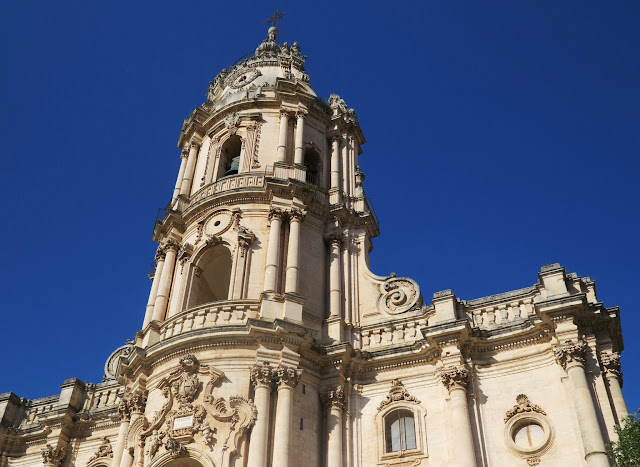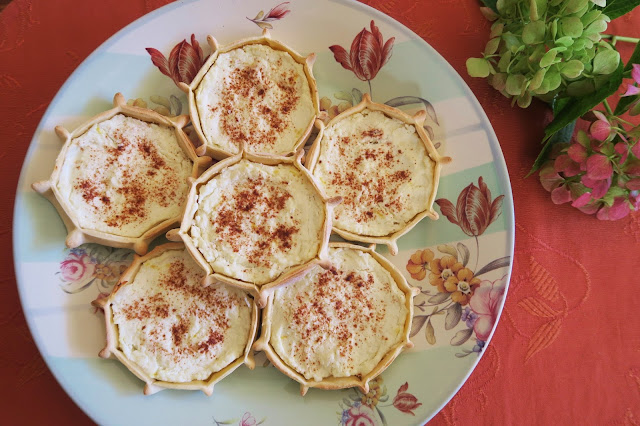Other than wanting to visit this city’s renowned chocolate factory I had heard so much about, I left the food suggestions to our hosts who knew where to find some of the best scacce. The early afternoon began with a chocolate fix, and eating the most amazing
cannoli siciliani that I have ever tasted at
Antica Dolceria Bonajuto. Here we sampled all sorts of chocolates as well as liqueurs and if organized in advance one can also book in a tour of the factory that has been around since 1880 and learn more about these six generations of artisan confectioners.
Scacce, although found in various areas of Sicily, they originate from the south-eastern side of the island and are typical of this pretty town. Scaccia ragusana is delicious paper thin yeast-less dough slathered with tomato and their local cheese. The dough is folded several times with a new coating of sauce and cheese each time. The end result once baked is a rustic looking roulade with a crispy exterior and a soft, saucy inside. It puffs up while it is baking and then deflates once you cut into it. The aromatics responsible for the sauce’s intense flavour are the fresh basil and garlic.
We sampled a variety of freshly baked scacce in Modica at L’Arte della Focaccia Rosticceria. Definitely their specialty with many to choose from - ones filled with meat, some with broccoli and others with spinach and cheese or tomato and cheese. My favourite from this city were the scaccie ragusane and based on what I tasted and some questions asked, I can confidently say that this recipe is very close to the real deal and very easy to make.
I recipe tested this scaccia after my friend Jessica wrote and told me about it along with her family’s recipe for another amazing variety made with eggplant and almonds I posted about here. I was super excited to sample it in Modica as well as in Palazzolo Acreide.
Scaccie Ragusane
The dough for this scaccia is made up
of flour and water, with no added yeast. The sauce is a simple marinara sauce,
which I think works best with tomatoes that are in season and at their
sweetest. If you make your own tomato passata at the end of summer, then I
recommend you use a jar of it. Alternatively a good quality substitute will
work just as well. The only aspect I could not replicate is the wood fired
oven; I’m still working on that! (PS: inserted for my husband to read) ;)
Ingredients:
1 1/2 cups all-purpose flour
1 1/2 cups strong bread flour
1 teaspoon salt
1/4 cup extra virgin olive oil
1 cup water
2 garlic cloves, crushed
1 400 g can crushed tomatoes
bunch of basil, torn
1 cup grated pecorino cheese or
caciocavallo
The dough can be made in a stand mixer
with dough hook, or alternatively combine flours in a large bowl and make a
well in the centre. Add salt and 2 tablespoons of the oil and rub flour and oil
together with your fingers until mixture resembles coarse peas.
Start adding water, about 2 tbsp at first,
and knead into soft dough. Keep adding water and kneading until the dough is
soft, smooth and no longer sticky. Cover the dough with a kitchen towel and let
rest at room temperature for 30 min.
Heat the remaining 2 tablespoons of
oil in a saucepan. Add the crushed garlic and cook for 1 minute; then add the
tomatoes, season with salt and cook until thickened and reduced for about 10
minutes. Add the basil and set the sauce
aside to cool.
Heat the oven to your highest setting.
My oven was set at 250 C / 482 F
On a large work surface, dust with
flour to prevent the dough from sticking, and roll the dough into a large thin
rectangle. Spread a thin layer of sauce on the dough and sprinkle with cheese.
Fold left and right sides of the dough to meet in the middle, and top with more
sauce and cheese.
Then fold top and bottom edges to meet
in the center, and cover with more sauce and cheese. Lastly, fold the pie over
into a roulade and transfer onto a baking sheet covered with baking paper.
(Save remaining sauce if any for dipping later.)
Bake for 10 minutes at the highest
setting – 250 C /482 F. Reduce oven to
180 C /356 F and bake until the dough is set and lightly charred, about 50
minutes. Cool before slicing and serving.
Enjoy!










Comments
Post a Comment